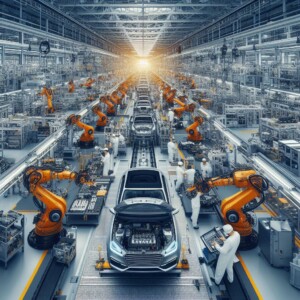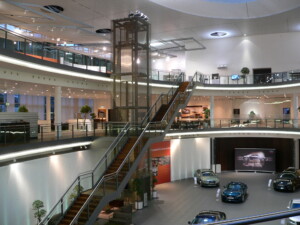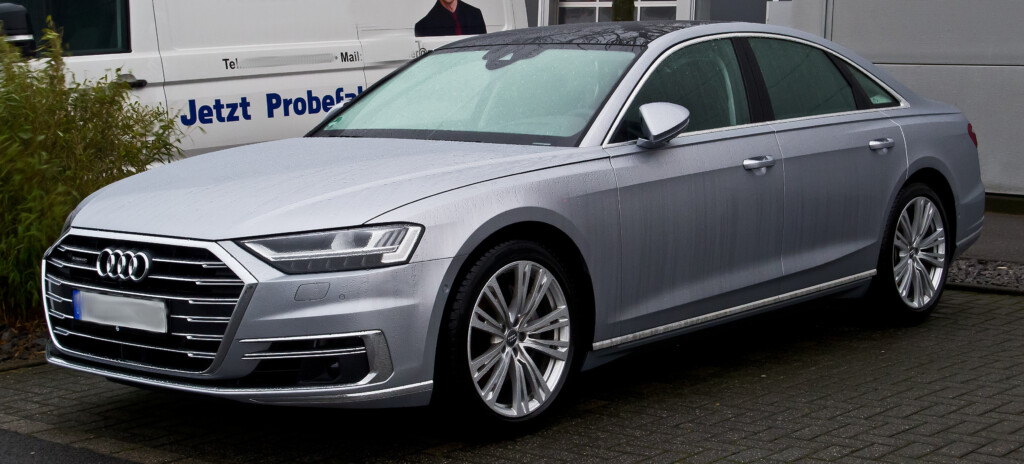 Recently I had the chance to visit the high-end luxury car assembly lines of two German car makers, Audi and Mercedes, making the Audi A8 and the Maybach respectively. The feel of these plants is more about craftsmanship than mass production, quite different from “normal” cars.
Recently I had the chance to visit the high-end luxury car assembly lines of two German car makers, Audi and Mercedes, making the Audi A8 and the Maybach respectively. The feel of these plants is more about craftsmanship than mass production, quite different from “normal” cars.
Audi A8
The Audi A8 is the luxury car of Audi, part of the Volkswagen group. They sell a few thousand every year. These cars come with 200- to 340-horsepower engines, which accelerate the two tons to up to 250 km/h. Normally, they are around 5m long, but the custom-order stretch version is 6.3 meters. Good luck finding a parking spot for that ship in Germany…but I assume the owners let the chauffeur worry about that. But you do get two extra side doors for a total of seven doors including the trunk.
The base version costs around 100 000 to 200 000 EUR, but this is before any of the many, MANY options. While entertainment systems and seat massage functions are almost standard in this category, for the Chinese market they offer a foot sole massage function. Apparently, Chinese customers like to take off their shoes in the car. In any case, almost anything is possible if you are willing to pay for it. Other must-haves like a humidor for your cigars, a fridge, and a coffee maker have also been found in different A8s, although these are not part of the normal extras. The armored version almost doubles the weight, and will set you back at least 700 000 EUR.
Maybach S Class
The Maybach was initially its own model with its own technology, but Daimler found out the hard way that designing a car costs a lot of money that you will never get back if you don’t sell enough of them. When they canceled the Maybach in 2013, I even wrote A Lean Obituary for Maybach – A Cautionary Tale About Cost of Complexity. Since 2015, the Maybach has been available again, but only a souped-up S-Class…but souped up it is! They sell around 5000 vehicles worldwide every year. The 300- to 500-horsepower engine will also accelerate the two tons to 250 km/h. The car is 5.47 m long, but the stretch version can be up to 6.5 meter.
A Maybach will set you back around 200 000 EUR for the base version, which is again before any of the many options are added, like heads-up displays, 360° cameras (really cool for parking!), rear-wheel steering, a fridge, and champagne glasses. The champagne glasses will cost you almost 4000 EUR, with which regular people can buy a used car. Obviously, an armored version is also available, starting at 500 000 EUR. This one includes flag holders if you want to fly two small flags on the sides of your hood.
Please note that both the A8 and the Maybach are luxury cars and at the end of the spectrum of Audi and Mercedes. However, this does not mean that there are not plenty of even more expensive luxury cars and sport cars like the Ferrari (from ca. 280 000 EUR), the Lamborghini (from ca. 200 000 EUR), the Rolls Royce (starting at around EUR 350 000 for the pauper’s version, but can be 100 times more for the Rolls-Royce Boat Tail), or the Bugatti (between 2 and 20 Million EUR) and more.
Audi Neckarsulm
 Audi Neckarsulm makes many of the higher-end models of Audi. Unusual for a car plant is that they produce on three floors on top of each other. Most modern car plants produce mostly on the ground floor, as moving cars up and down across floors is quite cumbersome. They produce 1200 cars per day, including around 128 of the top-of-the-line A8 per shift (in 2019). This would give a takt of around 3:20 min. However, when I visited the plant again in 2023, I estimated the takt being around 9 minutes per vehicle. Not quite sure where the difference came from. In any case, when observing the assembly line, my main impression was the slow pace. Workers idled a lot, and the work lacked any kind of urgency.
Audi Neckarsulm makes many of the higher-end models of Audi. Unusual for a car plant is that they produce on three floors on top of each other. Most modern car plants produce mostly on the ground floor, as moving cars up and down across floors is quite cumbersome. They produce 1200 cars per day, including around 128 of the top-of-the-line A8 per shift (in 2019). This would give a takt of around 3:20 min. However, when I visited the plant again in 2023, I estimated the takt being around 9 minutes per vehicle. Not quite sure where the difference came from. In any case, when observing the assembly line, my main impression was the slow pace. Workers idled a lot, and the work lacked any kind of urgency.
As usual, I estimate the efficiencies of assembly lines, and found a value added work only 40% of the time (in 2019). While it is a luxury car with many variants, this is not an impressive number. In 2023 it also felt slower. However, I also have seen worse, so it is not terrible either.
Daimler Factory 56, Sindelfingen
The Maybach assembly line is in Daimler’s Factory 56 in Sindelfingen, built in 2018. Daimler claims it is the most advanced automotive assembly line in the world (although I believe other car makers may disagree). All production is tracked by RFID chips, and at least part of the production is using AGVs. It is highly flexible, and all kinds of power trains are assembled on the same line, including diesel, gasoline, hybrid, and electric, both for the short(er) version and the long version of the Maybach.

The line has to handle a mind-boggling number of variants and options. For example, there are 700 000 variants for the dashboard alone. A theoretical calculation of all possible variants ends up with 9.9*10^20 variants (that’s 990 sextillion variants or 990 billion trillion variants). Hence, many of the products are delivered just in sequence, as the mass of variants would be otherwise unmanageable.
The main market is China, which buys 80% of the produced cars, with the stretch version being most popular. The line produces around 600 C-Class vehicles per day, at a takt of 2.5 minutes per car. The line works 24 hours around the clock, 5 days per week.
I love to estimate the efficiencies of assembly lines, and hence also checked what percentage of the time the workers were adding value. The Maybach assembly line, according to my estimate, has a value added time of the workers of 45%. This is actually not too bad. Obviously, Toyota and Nissan are best, having a percentage of value adding times up to 85%, but these are the best in the world, and it is for mass production at a takt of one car per minute. The Maybach has a much higher variety, and a much slower takt of 2.5 minutes per car, and a percentage value add of 45% is decent. (In comparison, the works automotive plant I have seen had a value add of only 30% despite a much faster takt).
Overall, a decent plant dedicated to the high-end brand. One thing that I never expected was that the day after my visit a disgruntled employee shot two supervisors. For American readers this may be almost normal, but in Germany this is highly unusual. Anyway…
Toyota Lexus Kyushu and Tahara

I also visited the Toyota Lexus factory in Kyushu. However, this is not a good comparison. While the above lines are for the high-end luxury vehicles, Toyota Kyushu makes a whole lot of models (the ES, UX, RX, and NX), which start at an affordable 40 000 EUR. I also visited the Toyota Lexus plant in Tahara (twice). This plant now makes the high-end LS model (from 120 000 EUR), but on the same line as the IS, GX, LX, and LS, along with a few Toyota models like the Land Cruiser.
Hence, their output is much higher, having the takt time for a normal automotive line of 74 seconds for Kyushu and 60 seconds for Tahara. The efficiency is also quite high with 69% for Kyushu and 58–66% for Tahara. Since their lines are much more flexible, running many more models, it would be difficult to compare this with the Audi A8 and the Maybach lines. In any case, I hope this was interesting for you. Now, go out, get your low-volume high-mix manufacturing under control, and organize your industry!




Great 👍
Thanks for sharing your experience and observations!
Interesting! I worked for NMUK before becoming a consultant 30+years ago. I spent 2~3 years 2~3 days a week at Sindelfingen just before they introduced the Maybach. Quite a few ex-Toyota people also entered the consulting field in the 1990s ….but they tended to drive Audis!!
HI Chris,
You have mentioned assembly of Electric Power train Maybach at Daimler Factory 56.
Do they also come in the power range of 300 to 500 Horse Power?
Wondering how huge the batteries may be.
Regards,
B. Jayaraman
Hi Jay, unfortunately I don’t drive a Maybach, and hence do not more about their product variety than what Google can tell me… 🙁
Interesting write up. Like your comments about efficiency but relative to priorities for both Damlier and Audi, I’d guess those are very low priorities relative to the product they are producing. I’m sure it was interesting to see how they handle all of those variations, which would be a high priority. What your article says to me is there is absolutely no ‘one-way’ to do this. You need to look at your customer base, treat your people in a humane way where they grow their skills, capabilities and critical thinking skills and determine what priorities require focus. It would be interesting in an environment like these to also see what they are doing in terms of environmental sustainability. You might check out this link https://drawdown.org/drawdown-roadmap Look at the write up on business responsibilities…it would be unit #5, if they continued the numbering.
Mechanics love to complain and hate German cars, but as far as assembly quality goes, it’s as flawless as it gets. You simply won’t see issues like missing bolts or misaligned body panels on anything made in Germany. The fact that they are usually over engineered with little or no regard for longevity or ease of service is a fault with the engineers, not the people who build them.
Here’s a long, but informative video where an Audi V10 engine is dismantled on video. Timing chains look like a magnified Rolex movement. AC compressor driven off of the timing chain and a shaft, and a liquid cooled alternator. SMH!!!
One question though. Is it true that higher end German cars age poorly because the German tax laws discourage business owners from keeping cars longer than five years? That’s the answer I’ve been told some years ago as to why all of the cars made by the big three in Germany have so many issues when they approach 100k miles and it only gets worse from there.
Forgot the link https://www.youtube.com/watch?si=RpnVkETPI9Hp4pR8&v=AMj5bIRqiLE&feature=youtu.be
Hi Andrey, in Germany, a lot of expensive cars are company cars, which are usually used for 3-5 years and then sold on the second hand market. Hence, the drop in value is more than the small economic cars that a lot of people want.